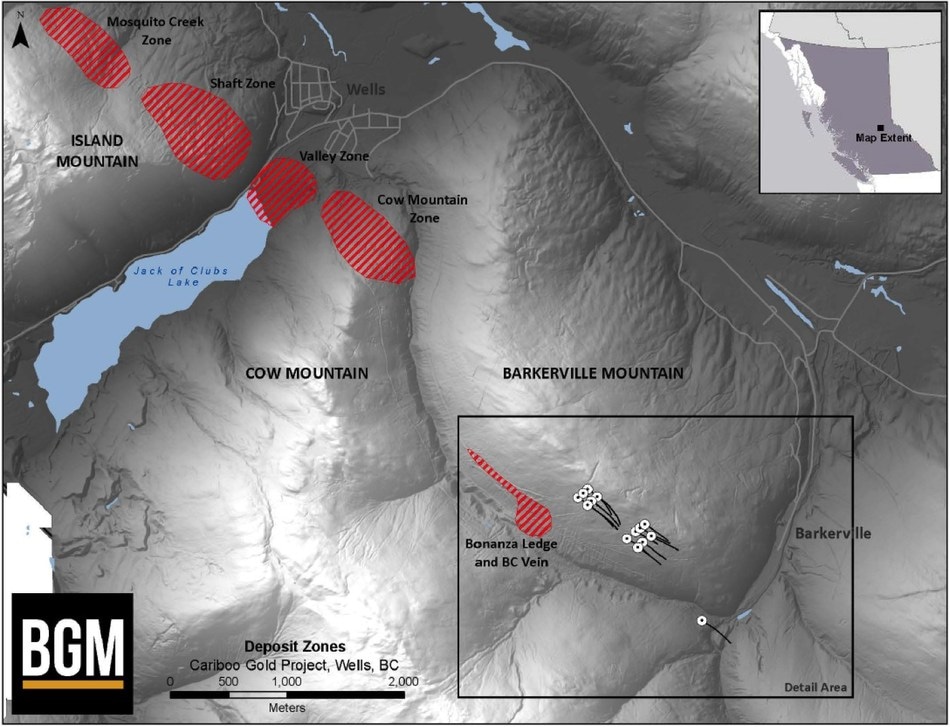Apr 24 2019
Barkerville Gold Mines (BGM) Ltd. reports new drilling results from its continuing Barkerville Mountain exploration program at the company's flagship Cariboo Gold Project in central British Columbia.
 Deposit Zones - Cariboo Gold Project (Image credit: CNW Group/Barkerville Gold Mines Ltd.)
Deposit Zones - Cariboo Gold Project (Image credit: CNW Group/Barkerville Gold Mines Ltd.)
In January 2019 BGM started diamond drilling with four diamond drill rigs on Barkerville Mountain. The continuing 25,000-meter Phase 1 exploratory drill program is fruitfully identifying new mineralized vein corridors akin to the vein corridors on Cow and Island Mountains. The apparent strike length for this new system on Barkerville Mountain is 1.5 km, defined from the company's complete lithological and structural mapping programs conducted during the last two years. Substantial gold values exist in all 14 of the preliminary holes.
These drill results show that the mineralized sandstone horizon which hosts the Mosquito, Shaft, Valley and Cow Resources on Cow and Island Mountains, covers vein corridor style mineralization an extra 2.5 km to the south east and is still open. Also this zone is situated 500 m from current underground mine infrastructure at the approved Bonanza Ledge mine.
Select Drilling Highlights:
- BM-19-003: 7.88 g/t Au over 2.00 m including 25.5 g/t Au over 0.60 m
- BM-19-003: 102.0 g/t Au over 0.50 m
- BM-19-004: 5.71 g/t Au over 2.60 m including 22.8 g/t Au over 0.60 m
- BM-19-005:19.30 g/t Au over 6.30 m including 69.40 g/t Au over 0.50 m
- BM-19-009: 9.86 g/t Au over 2.45 m including 21.9 g/t Au over 1.0 m
- BM-19-011: 54.6 g/t Au over 0.5 m
- BM-19-013: 12.23 g/t Au over 2.80 m including 33.60 g/t Au over 0.50 m
- BM-19-013: 40.10 g/t Au over 0.80 m
Real widths are estimated to be 50 to 75% of reported core length intervals. Intervals not recovered by drilling were allocated zero grade. Top cuts are yet to be applied to high grade assays.
Barkerville Gold Mines Ltd. 3D Deposit Model
Mineralized vein corridors on the Cariboo Gold Project are generally sub-vertical dip and northeast strike. Vein corridors are outlined as a high-density network of mineralized quartz veins within the F3 fold axis local to the sandstone horizons. Gold grades are closely related with vein-hosted pyrite, and intensely silicified wall rock haloes in close vicinity to the veins corridors.
Again these drill results demonstrate the high probability to add significant quality ounces along strike and near surface which shows the world class nature of this district. Additionally once a resource is defined in this area and adequate economic studies are complete, BGM could accelerate this area to production status after amending the existing Bonanza Ledge mine permit.
Chris Lodder, President and CEO, BGM.
Qualified Persons
According to the National Instrument 43-101 Standards of Disclosure for Mineral Projects, Maggie Layman, P.Geo. Vice President Exploration, is the Qualified Person for BGM and has prepared, confirmed, and approved the technical and scientific content of this press release. The company stringently complies with CIM Best Practices Guidelines in conducting, documenting, and reporting its exploration undertakings on the Cariboo Gold Project.
Quality Assurance – Quality Control
After receiving from the drill and processed, all drill core samples are sawn in half, labeled, and packed. The remaining drill core is then stored on site at the BGM’s secure facility in Wells, BC. Numbered security tags are fixed to lab shipments for chain of custody requirements. The company inserts quality control (QC) samples at systematic intervals in the sample stream, including blanks and reference materials with all sample shipments to track lab performance. The QAQC program was planned and approved by Lynda Bloom, P.Geo. of Analytical Solutions Ltd.
Drill core samples are given to ALS Geochemistry's analytical facility in North Vancouver, British Columbia for preparation and analysis. The ALS facility is accredited to the ISO/IEC 17025 standard for gold assays and all analytical techniques include quality control materials at set frequencies with recognized data acceptance criteria. The whole sample is crushed, and 250 g is pulverized. Examination for gold is by 50 g fire assay fusion using atomic absorption (AAS) finish with an upper limit of 100 ppm and a lower limit of 0.01 ppm. Samples with gold assays of more than 100 ppm are re-tested using a 1,000 g screen metallic fire assay. A selected number of samples are also tested using a 48 multi-elemental geochemical package by a 4-acid digestion, followed by Inductively Coupled Plasma Atomic Emission Spectroscopy (ICP-AES) and Inductively Coupled Plasma Mass Spectroscopy (ICP-MS).